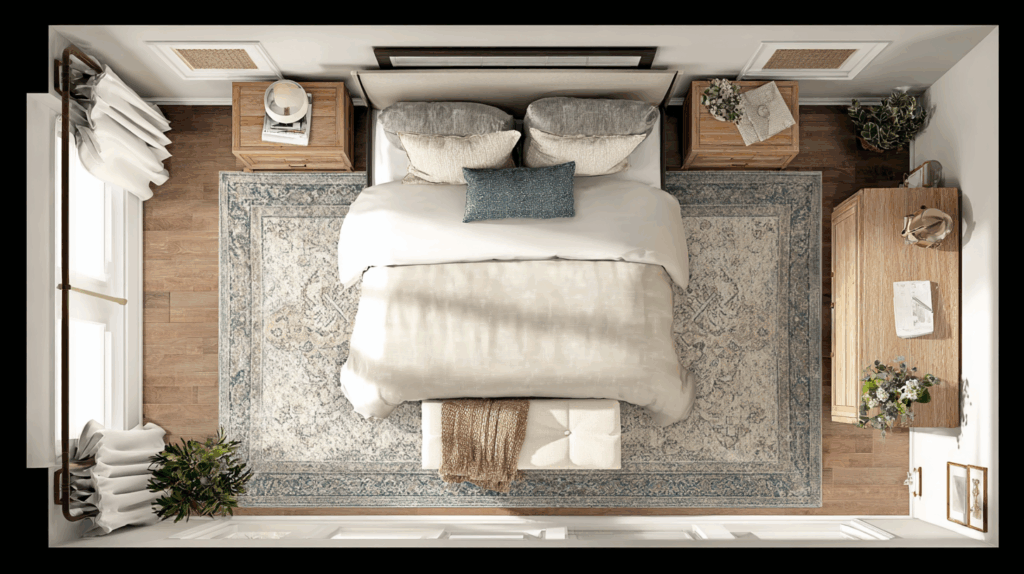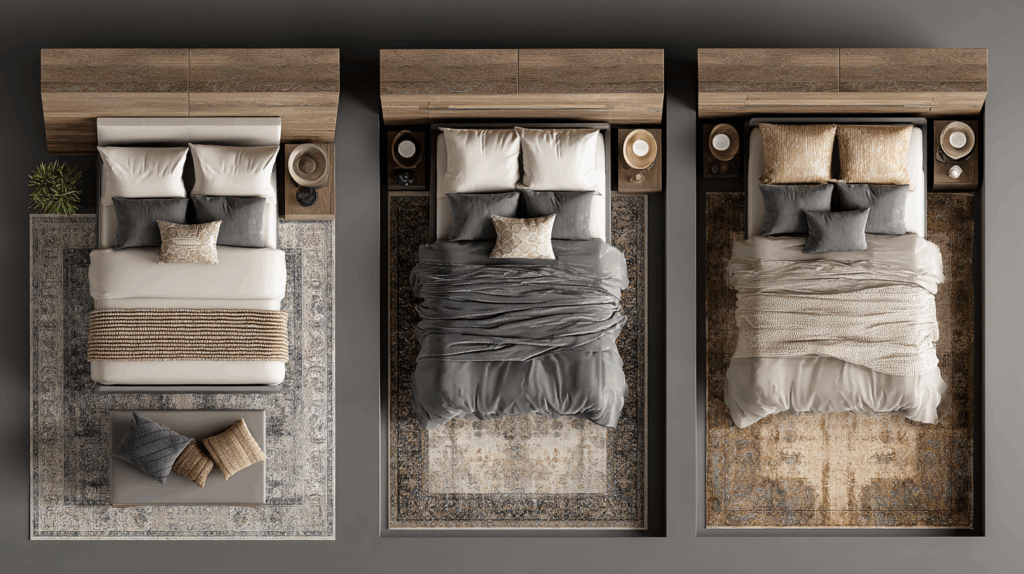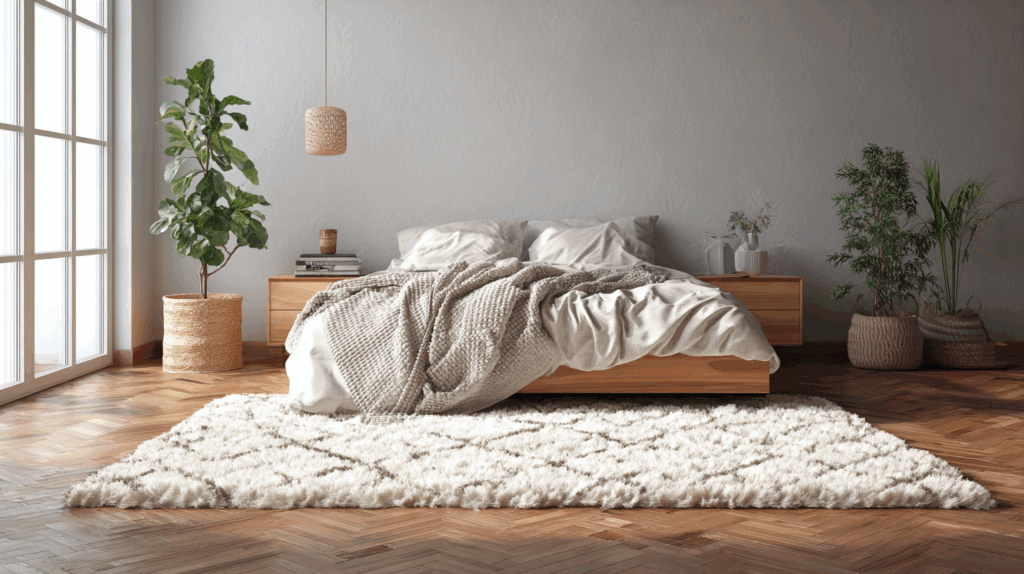Ever bought a rug and then stood there wondering if you put it under the bed the “right” way? Yeah, same.
When I first tried styling my bedroom, I kept second-guessing myself. Is it supposed to go all the way under? Should the nightstands be on the rug, too?
Turns out, there are no hard rules, but there are some helpful guidelines that make a big difference in how a room feels.
In this post, I’ll break down everything I wish I knew back then.
You’ll get simple tips for rug sizing, placement, and how to make sure it doesn’t look weird or messy. We’ll talk about materials, layout tricks, what mistakes to avoid, and even how to layer rugs like the designers do.
If you’re looking to warm up a cold floor or just pull your room together, you’re in the right spot.
Let’s get into it!
Why Use a Rug Under the Bed?

A rug under your bed isn’t just a decorative touch; it’s a practical addition that can completely transform your space.
If you’re aiming for extra comfort or to improve your room’s overall vibe, a rug brings multiple benefits that go beyond just looks.
- Comfort: Cold floors and bare feet? No thanks. A rug makes getting out of bed cozier and adds warmth to those first steps in the morning.
- Looks Pulled Together: A well-placed rug can ground your space, giving the room a clear focal point and creating a more cohesive, polished look.
- Noise Control: If you’ve got hardwood or tile floors, a rug can help absorb sound, making your space quieter and more peaceful.
- Floor Protection: Rugs are especially helpful if you move furniture around often or have pets, as they protect your floors from scratches and wear.
From added comfort to noise control and floor protection, a rug under the bed serves both form and function. It’s an easy way to increase your space while making it more comfortable and practical.
Basic Sizing Guidelines for Rugs Under the Bed

Now that you know why rugs are worth it, let’s talk about getting the size right. Too small, and it looks awkward. Too big, and it swallows the room. This is how to hit that sweet spot.
Length & Width Dimensions
If you want the rug to feel intentional (and not like a towel that wandered under your bed by accident), this is what helps:
- Leave about 18–24 inches of visible rug on both sides of the bed. This frames the space and gives your feet a soft landing.
- Let it extend 18–24 inches past the foot of the bed, too. That extra bit helps visually anchor everything.
- Think of the rug like a little stage your bed sits on. It should be big enough to support the “main act”, but not so big that it eats the whole room.
If your room’s smaller or you’re working around furniture, you can totally adjust. Just aim for visual balance, not exact measurements.
Rug Sizes by Bed Size
This is a cheat sheet I wish I had when I started rug shopping. It breaks down ideal rug sizes by bed type, plus when you can go smaller without it looking awkward.
| Bed Size | Best Rug Size | Smaller Option | Notes |
|---|---|---|---|
| King | 9×12 ft | 8×10 ft | 9×12 covers bed + nightstands. Use 8×10 if skipping nightstand coverage. |
| Queen | 8×10 ft | 6×9 ft | 6×9 works if you don’t mind the nightstands off the rug. |
| Full | 6×9 ft | 5×8 ft | Good size for guest rooms or smaller layouts. |
| Twin | 5×8 ft or a runner | 3×5 ft or side runner | A single runner on one or both sides works great. |
If your room’s tight, don’t force a big rug. Smaller rugs or side runners can still give you that cozy, finished look without crowding the space.
Remember, these are just guidelines, not rules written in stone. Your space, your style. No matter if you’re working with a small room or going for that luxurious, all-covered look, there’s always a way to make it work.
Go with what feels balanced, cozy, and makes you smile when you walk in.
Placement and Alignment for Rugs Under Bed
Once you’ve got the size down, the next question is: Where exactly does this thing go?
Most people default to centering the rug under the bed, and hey, that works great! But it’s not the only option.
Depending on your room layout, furniture, and how much rug you actually want to show, there are a few different ways to place it that still look polished (and don’t feel like guesswork).
I’ve listed some of those ways here for you to select:
- Full coverage: The rug goes completely under the bed and nightstands. It’s a clean, hotel-style look that works best with larger rugs and spacious rooms.
- Two-thirds under: The rug starts a little further down, usually just below the pillows or behind the nightstands, and extends past the foot. It saves on rug size and still looks intentional.
- Side coverage: Got your bed pushed against a wall or in a corner? Let the rug extend out on the exposed side instead of trying to center it. It helps balance the layout visually.
- Layered look: If your existing rug feels too small, try layering a larger neutral one underneath. It creates more dimension without replacing your original piece.
If it looks balanced and makes the space feel pulled together, you nailed it, even if it’s not “by the book.”
Rug Placement Rules for Different Layouts
Not every bedroom is laid out the same, and that’s exactly why a one-size-fits-all rug rule doesn’t really exist.
No matter if you’ve got a king-sized setup, wall-to-wall carpet, or you’re working with a tighter budget, there’s always a way to make rugs work for your space.
| Layout Type | What Works Best |
|---|---|
| King Bed | Go for 9×12 ft or bigger to match the bed’s scale and keep things grounded. |
| Queen Bed + Small Room | Try 6×9 or 5×8 ft, pulled two-thirds under. Saves space without losing style. |
| Wall-to-Wall Carpet | Use a flat rug with texture or pattern to layer and break up the flooring. |
| Budget Setup | Use 2 runners—one on each side or at the foot. Still looks polished and cozy. |
| Shared Room | Twin beds? Use one runner per bed or a large rug under both for unity. |
| Small Studio Space | A 5×7 or 6×9 rug under the lower half of the bed helps define the sleeping zone. |
Big room or tiny nook, there’s always a way to style it smart without overthinking it.
Rug Pads & Safety
Don’t skip the rug pad. Seriously, it’s one of those small things that makes a big difference.
A good rug pad does more than just sit underneath:
- Keeps the rug from sliding so you’re not constantly adjusting it (or tripping over it)
- Adds a bit of cushion underfoot, which feels especially nice on hardwood or tile
- Protects your floors from scratches, dents, and color transfer
If you’re using a flatweave or low-pile rug, go with a gripper-style pad to hold it in place. If the rug bunches or shifts when you walk, you’ll feel it, and it gets annoying fast.
It’s not the flashiest part of rug shopping, but trust me, it’s worth it.
Common Mistakes to Avoid
Even a great rug can look off if it’s placed incorrectly. These are the small things that often trip people up (myself included). But once you know what to watch for, they’re super easy to avoid.
- Rug too small: A tiny rug under a big bed can make the whole setup feel disconnected or unfinished.
- Unbalanced sides: If one side has 24 inches showing and the other barely has 5, it’ll throw off the visual flow.
- Nightstands half-on, half-off: Choose one approach. Either keep them fully on the rug or completely off. The same goes for benches or footboards.
- Rug pushed against the wall: Leave at least a few inches of floor showing around the rug’s edge. It helps define the space and keeps things from feeling cramped.
If your setup looks a little weird and you can’t quite figure out why, take a step back and check your spacing. Most of the time, a small shift makes a big difference.
Final Note
So, about those “rug under bed rules”, you’ve now got the key ones in your back pocket. You know how to size it, place it, pick the right material, and avoid the stuff that throws a room off.
If you came here wondering how to line things up right or if your rug even works under your bed at all, I hope this made things clearer.
There’s no one right answer, but these tips should help you make a decision that feels right in your space.
At the end of the day, trust what looks and feels good to you. These guidelines are here to guide, not box you in.
Now go enjoy your cozier, better-styled bedroom!

